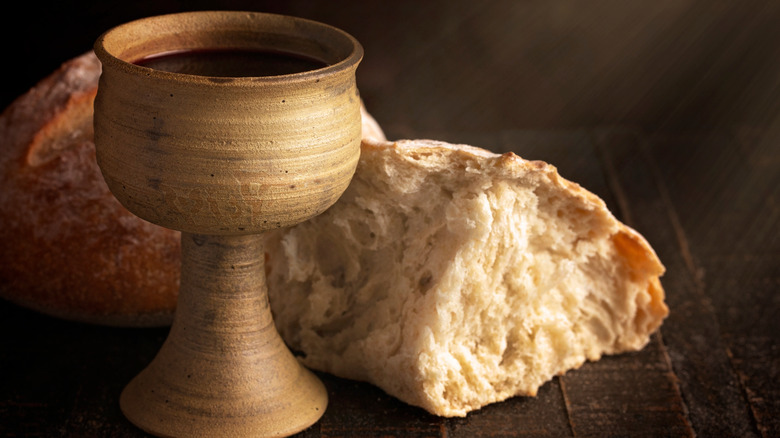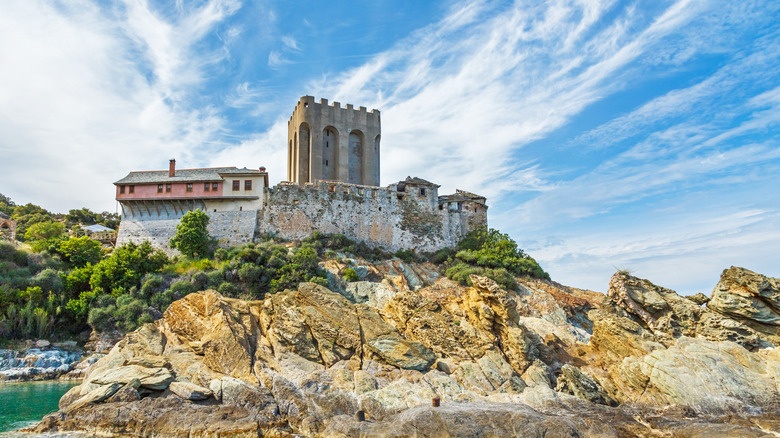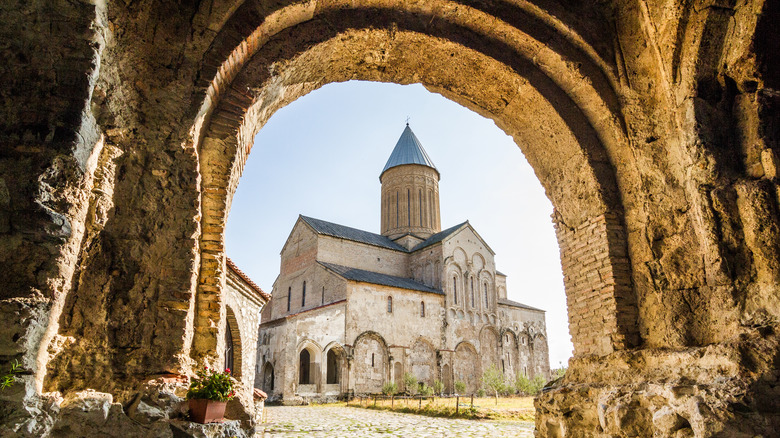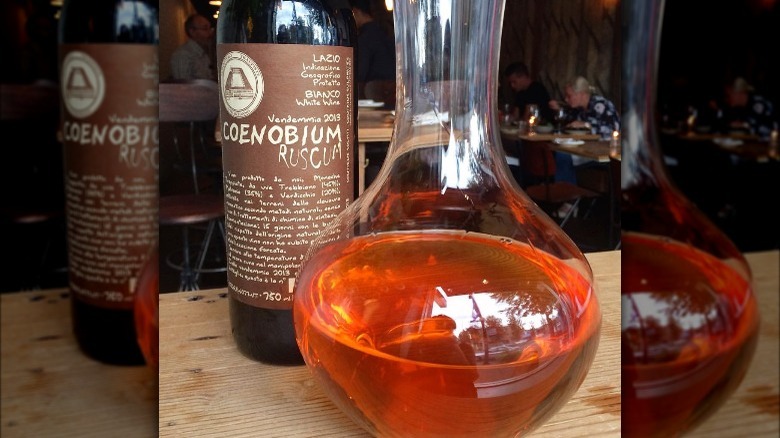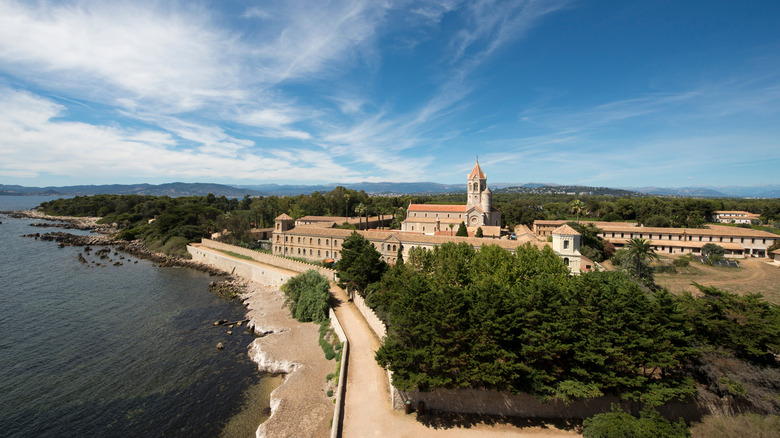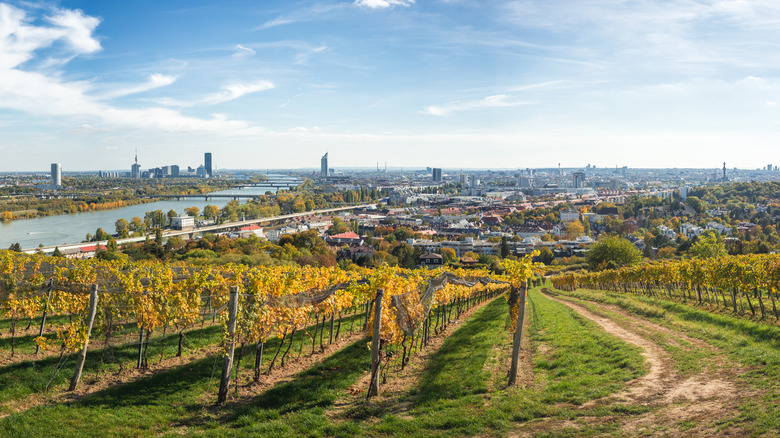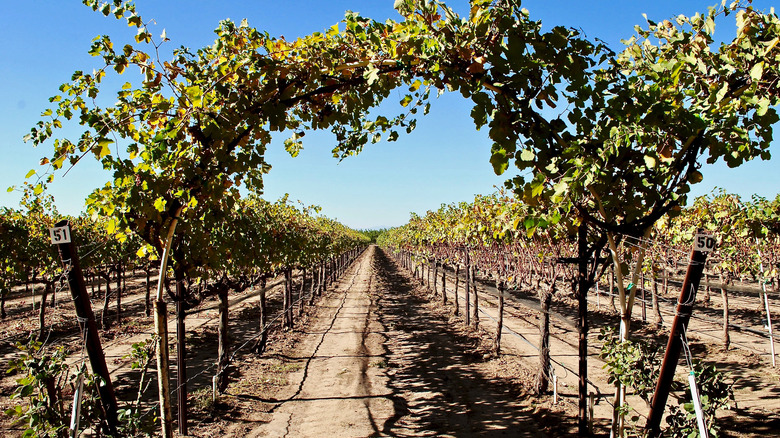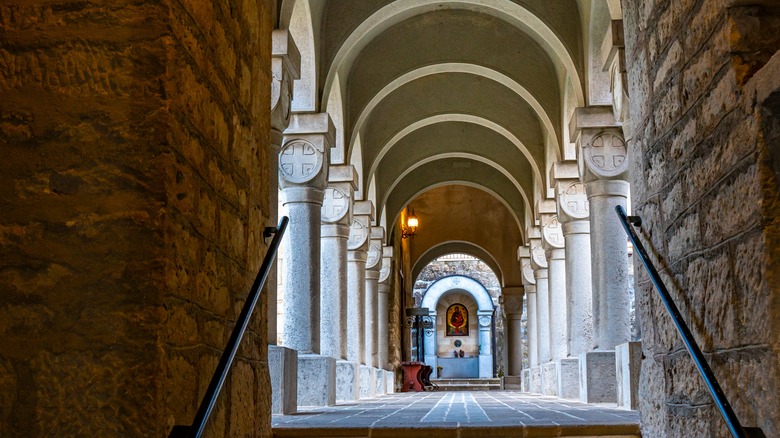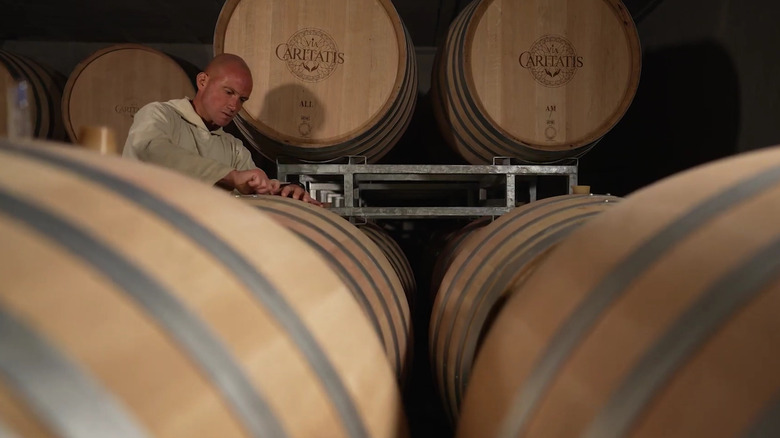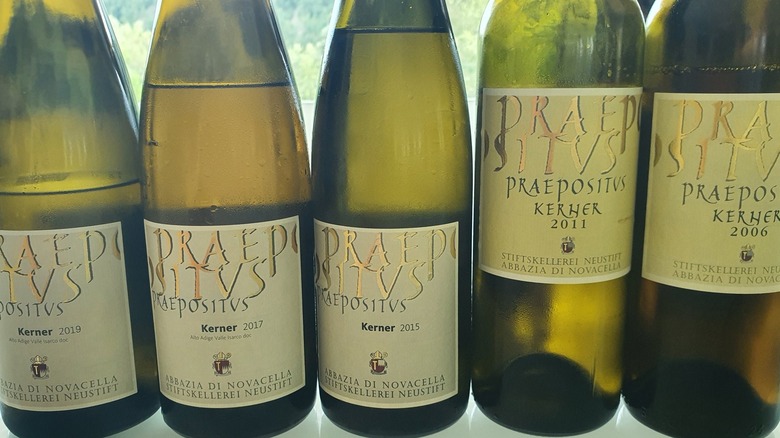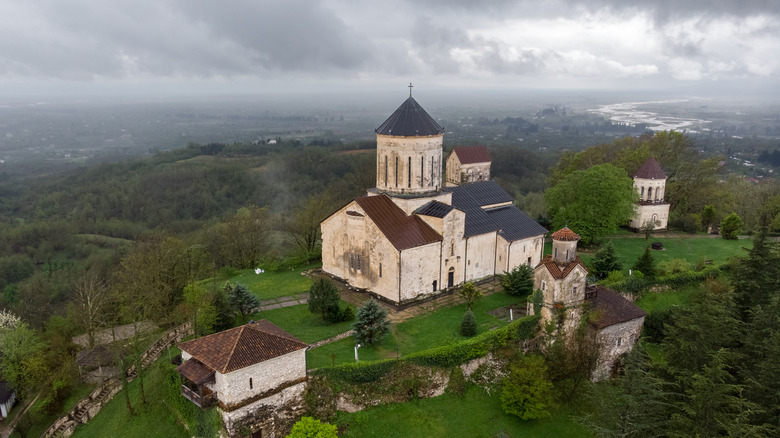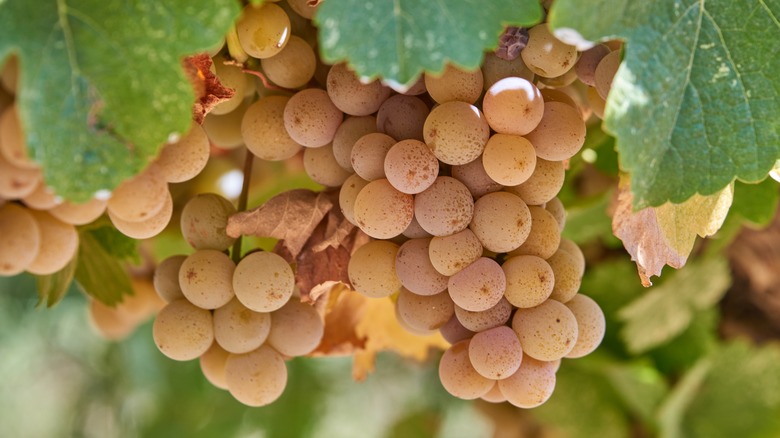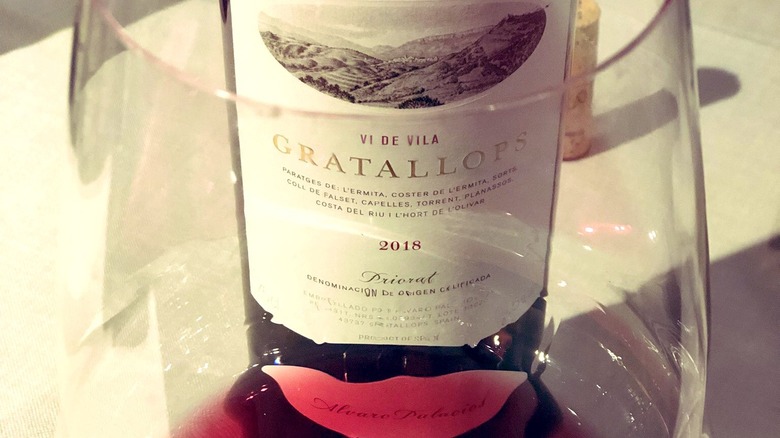The 12 Best Wines Made In Monasteries
Wine is one of the most prominent alcoholic drinks in the world with approximately 260 million hectolitres produced globally in 2020 (via Statista). The mass production of modern-day wine marks contemporary demand as extremely high, yet the beverage has been consumed for millennia. According to National Geographic, the oldest evidence comes from Georgia, where wine production is proved to have occurred 8,000 years ago. Throughout history wine has remained popular; Cleopatra was known to submerge herself in red wine, while the ancient Greeks and Romans worshiped the god of wine Dionysus.
Trading explains the proliferation of wine, but the question remains as to how an ancient drink made from fermented grapes became globally popular? The answer lies in religion. For Christians and Jews, wine holds symbolic importance, representing the blood of Christ for the former and featuring in the latter's holy rituals (via Fine Wine Master). As both Christianity and Judaism spread across Europe, South America, and beyond, wine followed.
By cultivating grapes at monasteries, monks ensured they had access to wine, which was needed to perform masses (via The Beauty & The Taste). Thus, monasteries became synonymous with the art of making wine. And although the production has ebbed over time, several proud monasteries still continue the ancient tradition.
Mylopotamos Epifanis - Monastery of Megisti Lavra, Greece
Greece's love affair with wine can be traced all the way back to ancient times when it stood proudly as the quintessential beverage in the Mediterranean (via World History Encyclopedia). Alas, the global popularity and esteem of Greek wine took a knock when mass-produced, cheap retsina (wine mixed with pine resin) came to the fore (via The New York Times). Despite its bad reputation, retsina — and to a greater extent all Greek wines — are due a renaissance as expounded by Jancis Robertson, The Financial Times' wine correspondent.
Greatly contributing to this turnaround are the monks of Megisti Lavra, a monastery situated on a windblown outcrop at Mylopotamos. Metochi Mylopotamos soon emerged as a vineyard where communion wine could be produced, though its fortunes ebbed and flowed throughout history. From 1990 to 2020, Monk Epifanios coordinated extensive renovations of both the winemaking facilities and vineyards.
The reward for his labor has been great, and the winery's red wine Mylopotamos Epifanis has received a number of awards from Decanter, Concours Mondial de Bruxelles (an international wine competition), and various other acclaims. This excellent wine is full of red fruit and spiced notes, rich tannins, and a pleasantly sweet aftertaste. As with the majority of wine produced by the Megisti Lavra monks, Epifanis is organic (via Top Greek Wines), meaning it has minimal impact on farmland.
Khikhvi - Alaverdi Monastery, Georgia
To the uninitiated, the idea of Georgian wine comes as a surprise, despite the fact that wine has been produced there since the Stone Age, according to National Geographic. As reported by The New York Times, its limited proliferation into Western culture is largely due to the collapse of the Soviet Union and the ensuing civil war that wracked the country. The so-called Rose Revolution established some control, and Georgia began to open up to the exterior (via The Guardian).
For the monks of Alaverdi Monastery, a pivot toward the West aided their wines in becoming the talk of the wine world (via Atlas Obscura). Chief among these celebrated wines is Khikhvi, an amber-colored wine produced with grapes of the same name (via Wine Anorak). As with all of the wines at Alaverdi, Khikhvi is produced underground in clay pots called qvevri, an ancient technique, that, as reported by The Morning Claret, facilitates greater skin contact time. This allows the wine to develop a complexity unseen in wine made using more conventional methods. Khikhvi produced in this manner releases strong floral aromas that coexist alongside flavors of dried apricot (per Georgian Wine).
Coenobium Ruscum - Monastero Suore Cistercensi, Italy
Historically, the leading figures in the wine industry have been male. Florent Schepens, Professor of Sociology at Université de Bourgogne, explained to Monaco Tribune that part of the misogynistic and fallacious reasoning behind this was that women would have a negative effect on the resulting wines.
Of course, beliefs such as these are subsiding with time, yet a macho grip remains wrapped around most vineyards and wineries. Fortunately, a group of nuns based at Monastero Suore Cistercensi are proving that excellent wine can be made by women. The advice of famed wine consultant Giampiero Bea, when combined with the traditional, organic, labor-intensive means that the sisters farm their five hectares of vineyards with (via Skurnik), have resulted in the production of startlingly good wines. Chief among these is Coenobium Ruscum, an orange wine known for its acidity, punch, and dryness (via Astor Wines).
Much of the limited stock of Coenobium Ruscum is exported to America by Rosenthal Wine Merchant. It's the result of a working relationship that Rosenthal founder Neal Rosenthal particularly enjoys. "It is a special joy working with the sisters ... The smiles, always present, on the faces of the sisters convey the richness of their humble lives," Rosenthal told Fortune.
Saint Salonius - Abbaye de Lérins, France
As reported by France Today, although monasteries had an important influence on winemaking in France, only a small number of wine-producing monasteries remain. The most prominent of these is undoubtedly Abbaye de Lérins, a fortified Cistercian monastery located on Île Saint-Honorat. Here, about 20 monks produce one of the best red wines in France made entirely from the highly versatile and globally popular Pinot Noir grape.
Saint Salonius, the aforementioned wine, is a certified stunner beating two highly respected Pinot Noirs from Burgundy during a blind tasting (via Decanter). Perhaps this should come as little surprise, the flagship wine of Abbaye de Lérins is so well thought of that it has been served during numerous high-profile events, most notably at the Cannes International Film Festival and the G20 summit (via Abbaye de Lérins). Those lucky enough to procure a bottle can expect to be amazed by the exceptional mouthfeel of the wine alongside prominent tasting notes of red fruits (via Abbaye de Lérins).
Pinot Noir Reserve - Stift Klosterneuburg, Austria
As the only capital city with its own viticulture, Vienna can lay claim to one of the most illustrious and sustained wine histories in the world (via Discover Germany, Switzerland & Austria). Key to the maintenance of such diverse viticulture is the longstanding enablement of all Viennese residents to sell self-produced wines (via ad vineas). Heuriger inns, the establishments in which these wines are sold, have become wildly popular in Viennese culture and economically support Vienna's estimated 230 growers.
One such grower is Stift Klosterneuburg, an abbey, and Austria's oldest winery located north of the capital. Stift Klosterneuburg cultivates vineyards across four different sites, paying particular attention to soil health and biodiversity (via Stift Klosterneuburg). Such attentiveness can only be achieved by utilizing human labor wherever possible, and by incorporating time consuming processes such as fertilizing the vineyards. Benefiting from this hands-on approach is the abbey's Pinot Noir Reserve, a bold and prominent red wine that has previously been awarded 93 points by the Falstaff Red Wine Guide (via Stift Klosterneuburg).
Moschofilero - The Abbey of New Clairvaux, United States
Despite challenges posed by climate change, and entrenched underrepresentation, Californian wine is currently going strong. As reported by The New York Times, winemakers have become increasingly able to express their creativity and have consequently produced truly sensational vintages. This pioneering approach seems to be rubbing off on all the area's winemakers including the Trappist monks of New Clairvaux.
On two separate, 15-acre vineyards the brothers grow a dozen different varieties of grapes (via New Clairvaux Vineyard). Amongst them, you will find the familiar Tempranillo but also two Greek varieties — Assyrtiko and Moschofilero. These grape varieties are a new experience for head winemaker Aimée Sunseri, an unsurprising fact when neither variety had ever been grown in the U.S. before (via Vine Pair).
Tending the vineyards not only supports the monks economically but also aids in their personal development, as stated by Brother Rafael to NPR. "One thing that has been extremely helpful for me is to know myself by pruning," explained Rafael. "What you do with the vines is you're constantly removing what is extra. You remove the extra clusters, you remove the extra leaves and canopy. For what? ... It's the same with me in my interior life. I need to remove what is superfluous." The result of their labors is impressive. The 2020 Moschofilero was awarded 95 points at the New York International Wine Competition and is known for citrus tasting notes and an extremely clear smell of grapes (via New Clairvaux Vineyard).
Black Tamjanika - Bukovo monastery, Serbia
Serbian wineries established themselves during the Nemanjic dynasty, a period of medieval rule that lasted from the 12th century until late in the 14th century (via Wine Travel). However, a great number of these vineyards have been lost over the centuries due to a myriad of reasons. Most prominent amongst these was undoubtedly the introduction of phylloxera, an aphid that eats the roots of grapes. After coming from North America in the 19th century, the aphids resulted in the destruction of vineyards across Serbia and wider Europe (via Wine Brotherhoods).
Serbia's prized possession, a native and rare variation of the Muscat grape called Tamjanika only just survived, with the dark variety of the grape, known as Black Tamjanika, almost being labeled extinct at the turn of the 20th century, according to Wine Travel. In cooperation with multiple local schools and services (via The Slow Food Foundation), Bukovo monastery has created a robust vineyard full of Black Tamjanika. The harvested grapes are now used to produce a highly unique wine, which due to the Muscat origins of the grape, impart incredibly light flavors and persistent aromas (via Dan Company). As such, the wine is best paired with clean, simple foods.
Lux Amoris - Abbey of Le Barroux, France
For Christians, charity stands as one of the seven heavenly virtues. As such, it forms a key part of any practicing Christian life, especially for those who have dedicated themselves to the honor and service of God. The monks and nuns of the abbey of Le Barroux, which is situated in the Rhȏne valley, have epitomized this Christian approach by using the medium of wine. As reported by Eurasia Review, the Benedictine monks and nuns have tirelessly cultivated the vineyards throughout the years, often with the goal of raising money to support the local winemaking community.
Aside from the virtuous nature of its work, the Abbey of Le Barroux has also produced some outstanding wines. Theirs are the world's oldest papal vineyards (via Aleteia), and the prestigious grapes sit nestled amongst the Mount Ventoux where an array of terrain, soil types, and altitude provide the abbey of Le Barroux with the ability to grow a number of grape varieties (per Via Caritatis). This varied terroir, when coupled with the abbey's painstaking attention to detail, has resulted in the creation of many high-caliber wines, such as Lux Amoris. This wine has been particularly well-received thanks to its vivid appearance and nuanced flavor (via Earth Labora).
Kerner - Abbazia di Novacella, Italy
Abbazia di Novacella is one of Italy's northernmost wineries, situated close to the Austrian border (via Opening a Bottle). Here the soil stands in stark contrast with the rich, fertile soils often associated with the Mediterranean (via ScienceDirect). Instead, as reported by Skurnik, the soil which surrounds Abbazia di Novacella is constituted of schist, a hardy, metamorphic soil.
Whilst posing challenges for anyone wishing to hoe a vegetable patch, schist brings numerous advantages for winemakers. Speaking to Wine Enthusiast, Mike Evans, founder and CEO of The Vines explained "On the way [down], the roots absorb lots of minerals, which is known to give low yields of small grapes with thick skins but a high concentration of flavors, color, acidity, and tannins. The result is highly intense and aromatic, often big and bold ... but always with a lot of what we call 'mineral' notes."
Celestino Lucin, head winemaker at Abbazia di Novacella has definitely put the soil and the vines to good use. Voted winemaker of the year in 2009 by Gambero Rosso (a multifaceted Italian wine platform), Lucin has guided Abbazia di Novacella wisely, developing a reputation for producing outstandingly good, cheap bottles (via Skurnik). The abbey is best known for its Kerner, a light wine with citrus that cuts the palate and of course, mineral notes (via One Brilliant Bottle).
Ojaleshi - Martvili-Chkondidi Monastery, Georgia
You may know polyphenols as the health-boosting compounds found in dark chocolate, berries, and red wine. Studies have shown polyphenols to act as antioxidants, neutralizing free radicals and helping to reduce the risk of developing cancer, diabetes, and heart disease, according to the International Journal of Biomedical Science). However, polyphenols not only influence the health impacts of wine, but also how it tastes, looks, and feels in the mouth (via Molecules).
As reported by Code de Vino, the high polyphenol count found in Ojaleshi, a grape variety native to Georgia, is one of the things that makes the wine produced, under the same name by the Martvili Chkondidi monastery, stand out. Another factor that makes this semi-sweet wine special is the late nature of harvest which allows the berries to build up an extremely high sugar content, nearly a quarter of their whole mass. This results in a self-stabilizing, rich wine being created by the monastery. On drinking, the flavor notes are unsurprisingly dominated by that of sweet berries.
Gewurztraminer - Latrun monastery, Israel
After a period of prolonged effort and investment, Israel's wine sector has undergone something resembling a revolution. Both quantity and quality of wine produced in the country has increased dramatically as typified by the six gold medals awarded to Israeli wines at the 2020 Decanter World Wine Awards (via Wines Israel).
Under the guidance of Palestinian winemaker Adam Kassis, Latrun Trappist monastery has updated its winemaking process, churning out 200,000 bottles a year (via The Jerusalem Post). Throughout this process, Latrun has contributed to the growing excitement surrounding Israeli wines by becoming one of few Israeli wineries to cultivate Gewurztraminer. This grape variety, which hails from Alsace, is known to produce extremely pungent wines, with a very pronounced fruity hit on the tongue. How these characteristics evolve when the grape is grown in Israel remains to be fully seen, but the Gewurztraminer vintages thus far, as well as those from other grape variants, indicate a promising viticultural future for the Latrun monastery.
Priorat - Ruins of Scala Dei Monastery, Spain
Spain has a long and illustrious wine history, producing industry giants such as Rioja and Albariño. The former, an emblematic wine, was awarded Spain's highest honor in 1991 when it was promoted to DOCa status. As per Wine Traveller, this status is only given to wines that maintain consistently high levels of quality for prolonged periods of time. For nearly a decade Rioja was the only wine deemed to have achieved this lofty peak and stood alone as the ultimate in Spanish wine production.
That is until those cultivating the vineyards at Scala Dei Monastery, which was constructed in the 12th century, abandoned large-scale wine production and decided to focus on quality instead (via Wine-searcher). Since that decision, the wine produced in this pocket of Catalonia, called Priorat, has grown in both esteem and price. A revelation that was formalized when Priorat joined Rioja as only the second DOCa status wine in Spain, according to Wine-searcher.
Whilst the vineyards were originally planted and tended by monks of the Carthusian Order, the expropriation of Spanish monasteries that occurred during the 1830s led the monks to flee and the monastery to fall into ruin (via SUR). Since then, cultivation has been managed by 99 registered wineries across the monk's old land (via Decanter). Today, wine production occurs in their former stables (via Spanish Wine Lover), ensuring that their contribution to this land is never forgotten.
